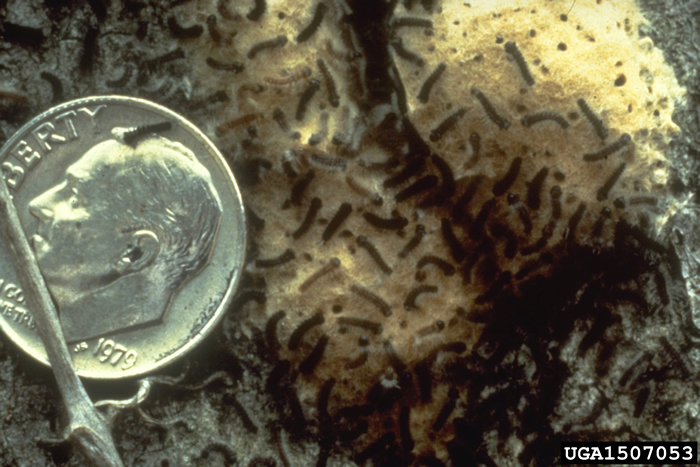April 11th, 2016
Preparing your property for this year’s Gypsy Moth explosion!
The start of Gypsy Moth season is here. The egg masses laid last fall will begin to hatch around mid April, so now is the time to prepare your trees and stop another year of devastating caterpillar defoliation.

If you didn’t do so in the fall, you should go out and assess your property for gypsy moth egg masses. Egg masses can usually be found in dark, protected areas often on tree trunks and branches, under window sills, in doorways, underneath outdoor furniture, on brick or rock walls, under gutters, decks, wood piles and woodsheds... just about anywhere.
Once found, you need to remove and destroy before the caterpillers emerge in the spring. To remove egg masses, slide the blade of a knife or paint scraper under the egg mass, lift the mass off and put it in a collection bucket full of warm, soapy water overnight. Simply leaving them on the ground after removal does not kill the eggs. They must be destroyed.
Reference: Gypsy Moth Management for Homeowners - Purdue University
Creating Barrier Bands on trees to capture Gypsy Moth caterpillars
One of the most effective methods in capturing and killing gypsy moth caterpillars is to wrap trees on your property with a barrier band.
Reference: NJ.gov - Controlling Gypsy Moth Caterpillars with Barrier Bands
Hiding Bands
Older gypsy moth caterpillars migrate down the trunk of the tree during the heat of the day to find shade and to hide from predators. They move back up the tree in the evening to feed. Burlap bands can be wrapped around tree trunks to collect caterpillars that hide during the day. Caterpillars can be collected in the afternoon and disposed of to reduce the gypsy moth population.
- Cut a strip of burlap or medium weight dark cloth about 12 to 18 inches wide and long enough to completely encircle the tree.
- Wrap the burlap around the tree at chest height.
- Tie string or twine or wrap wire around the burlap 6 inches from the top edge. Then fold the top part of the cloth down over the bottom half, creating a tent-like area for caterpillars to hide in.
- Check the bands every afternoon. Wear gloves or use tweezers to collect the trapped caterpillars and drop them into a bucket of soapy water (use dishwashing liquid).
- Let caterpillars soak in the soapy water a day or so before discarding them to make sure they are dead.
Reference: Control of Caterpillars - Purdue University
Purchase: Order rolls of Burlap on Amazon
Sticky Bands
Sticky bands around trees are used to capture and collect caterpillers by wrapping bands made from duct tape, aluminum foil, burlap or plastic food wrap around the trunk of the tree around chest height.
Once bands are installed, apply a sticky substance such as Tanglefoot, bug gum or bug glue to the band. (Avoid getting it directly on the tree as it can damage or stain the bark.) Tanglefoot is a sticky substance made specifically to manage small crawling insects.
- Place protective band on tree prior to applying because it protects the bark against staining, the product will last longer, and it is easier to clean up.
- Apply Tanglefoot 2 - 3 inches wide, 1/16 of an inch thick.
- Band can be left on the tree for 6 months to a year, depending on the severity of the infestation, but should be removed at the end of the season.
- Proven to work against canker worms, gypsy moths, caterpillars, ants, root weevils, moths, and cutworms.
- Approved for use in organic gardening - OMRI Certified
Purchase: Order Tanglefoot on Amazon
Purchase: Order rolls of Burlap on Amazon
So get out there and save some trees! Good luck!

